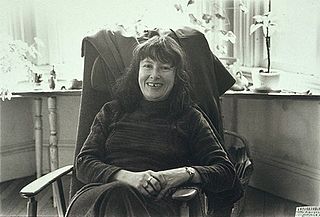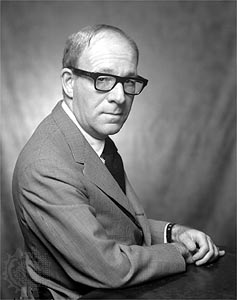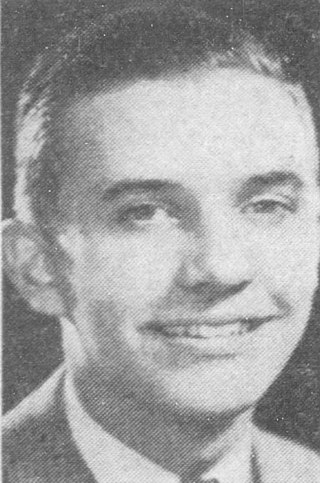
The Lordly Hudson is a poem and 1962 book of collected poetry by Paul Goodman.

The Lordly Hudson is a poem and 1962 book of collected poetry by Paul Goodman.

Richard Kostelanetz wrote that Goodman's title lyric was his most memorable line: [1]
This is our Lordly Hudson hardly flowing
under the green-grown cliffs
and has no peer in Europe or the East.
Be quiet, heart! Home! Home!
Goodman wrote the poem in February 1937 in reference to his Manhattan homecoming. He was returning by bus during a break from his second semester at the University of Chicago. [2] The text reflects a "passionate pride in home (Manhattan) and a patriotic elation in things familiar". [3] "The Lordly Hudson" was titled "Poem" when published in Five Young American Poets, Second Series (1941). [4] The phrase "lordly Hudson" had been first penned by Washington Irving in the early 1800s. [5]
It became Goodman's most famous poem. [6] American essayist Emile Capouya called "The Lordly Hudson" the greatest New York poem since Walt Whitman. The poem, wrote Capouya, represents Goodman's direct, unsophisticated rhetorical style, which pulls from staid virtues like patriotism. [7] Poet Judson Jerome laughed aloud reading the title lyric for the first time and was surprised to realize that Goodman meant it seriously. [8] What made the poem great, said Gordon Burnside for the St. Louis Post-Dispatch , was Goodman's "patriotic love ... underneath its kidding and fooling". [6]
Goodman continually revised his poems. "The Lordly Hudson" appears in its edited form in his 1972 Collected Poems . [9]
Composer Ned Rorem put Goodman's poem "The Lordly Hudson" to art song. [10] Rorem first met Goodman in 1938 at a weekly poetry reading in Chicago, when Rorem was an early teenager. Goodman became Rorem's foremost social and poetic influence, [4] his "Manhattan Goethe". [11] Rorem said he had no background in American art songs before he wrote "The Lordly Hudson". He was inspired to set Goodman's poem to song after hearing Francis Poulenc's "C" setting of Louis Aragon, particularly the vocal interval "de la prairie", at a New York Christmas party in 1946. Though he had struggled to set the poem to music before, Rorem wrote the song in one session the next day, beginning with the "Home! Home!" and "No, no!" parts. [4] The result is lyrical and dramatic, with arching, high emotion intervals and "supple melodic phrases" recalling the Hudson River's grandeur atop a "strong rhythmic chordal accompaniment". [3]
Soprano Janet Fairbank, who was known for new American songs, premiered the work without changes. It was known then as "Poem" and later became "Driver, What Stream Is It?" before Goodman titled it "The Lordly Hudson" for the song's publication by Richard Dana. Fairbank died on the day of its publication in 1947. The song was dedicated to her. [4]
The Music Library Association recognized Rorem's "The Lordly Hudson" as the best published song of 1948. [10] It launched his career [12] [13] as his first song, [14] becoming one of his best-known and most-sung. [15] [3] Rorem would continue to set poetry by Goodman to song throughout his career. [16] [3] [17] Vocalists Susan Graham [18] [19] and Nathan Gunn have recorded performances of the song. [20] [21] "The Lordly Hudson" became a cultural touchstone of New York City. [22]
| Author | Paul Goodman |
|---|---|
| Publisher | Macmillan |
Publication date | 1962 |
The Lordly Hudson: Collected Poems is divided into seven sections: Short Poems, Longer Poems, Stories, Sonnets, Ballades, Love Poems, and Sentences and Prayers. [23]
The Macmillan Company published The Lordly Hudson: Collected Poems in October 1962, with a paperback to follow three months later. The manuscript is held in the Syracuse University special collections. [24] The collection's namesake poem is printed on its cover. [8] Goodman communicates that his intent is for the collection to embody an attitude rather than writing beautiful poems. [8] Several of the poems have gay themes. [25]
Poet Harvey Shapiro wrote that the poetry in The Lordly Hudson, Goodman's first solo collection, was "the purest version of his thought ... always serviceable, sometimes awkward ... by rips and starts brilliant." [1] Jerome, on the other hand, found the collection mired in "awkwardness, wordiness, and pointless toying" and that Goodman's attitude comes across in themes of "indiscriminate sexuality, ... admiration for power and shock, plainness and simple pleasures, and an ego throbbing like swollen flesh". [8]
Poet Denise Levertov considered Goodman's poems to be on par with his short stories, which she said were among America's greatest. [26] While she considered half of the book's poems to be exceptional, she deemed others exceptionally bad, yet considered Goodman's strength to be the total effect of his voice coming throughout the collection, rather than the quality of individual poems. [27] She found his story poems, however, to be unsuccessful, [23] and his "Red Jacket (Lake Seneca)" to be her favorite. [26]

Sylvia Plath was an American poet, novelist, and short story writer. She is credited with advancing the genre of confessional poetry and is best known for The Colossus and Other Poems (1960), Ariel (1965), and The Bell Jar, a semi-autobiographical novel published shortly before her suicide in 1963. The Collected Poems was published in 1981, which included previously unpublished works. For this collection Plath was awarded a Pulitzer Prize in Poetry in 1982, making her the fourth to receive this honour posthumously.

William Carlos Williams was an American poet, writer, and physician closely associated with modernism and imagism.

Priscilla Denise Levertov was a British-born naturalised American poet. She was heavily influenced by the Black Mountain Poets and by the political context of the Vietnam War, which she explored in her poetry book The Freeing of the Dust. She was a recipient of the Lannan Literary Award for Poetry.

Ned Miller Rorem was an American composer of contemporary classical music and a writer. Best known for his art songs, which number over 500, Rorem was considered the leading American of his time writing in the genre. Frequently described as a neoromantic composer, he showed limited interest in the emerging modernist aesthetic of his lifetime. As a writer, he kept—and later published—numerous diaries in which he spoke candidly of his exchanges and relationships with many cultural figures of America and France.

Michael Dana Gioia is an American poet, literary critic, literary translator, and essayist.

Howard Moss was an American poet, dramatist and critic. He was poetry editor of The New Yorker magazine from 1948 until his death and he won the National Book Award in 1972 for Selected Poems.
Nationality words link to articles with information on the nation's poetry or literature.
Nationality words link to articles with information on the nation's poetry or literature.
Andrew Glaze was an American poet, playwright and novelist. Much of Glaze's poetry reflects his coming of age in the American South, and his eventual return there. He also lived and wrote in New York City for 31 years. In New York City he became part of a circle of poets that included Oscar Williams, Norman Rosten, John Ciardi and William Packard.

Growing Up Absurd is a 1960 book by Paul Goodman on the relationship between American juvenile delinquency and societal opportunities to fulfill natural needs. Contrary to the then-popular view that juvenile delinquents should be led to respect societal norms, Goodman argued that young American men were justified in their disaffection because their society lacked the preconditions for growing up, such as meaningful work, honorable community, sexual freedom, and spiritual sustenance.

The Empire City is a 1959 epic novel by Paul Goodman.

Collected Poems is a book of Paul Goodman's collected poetry, edited by his literary executor Taylor Stoehr and introduced by George Dennison.

Charles Aufderheide was an American technician who, with Ruby Bell and the From twins, Isadore "Eddie" and Sam From, was at the center of the Benton Way Group.

Making Do is a 1963 novel written by Paul Goodman and published by Macmillan.

Paul Goodman described himself as a man of letters but foremost a poet. He published several poetry collections in his life, including The Lordly Hudson (1962), Hawkweed (1967), North Percy (1968), and Homespun of Oatmeal Gray (1970). His Collected Poems (1973) were published posthumously.
Paul Goodman's oeuvre spanned fiction, poetry, drama, social criticism, psychoanalytic theory, and literary analysis. While he viewed himself as a man of letters, he prized his stories and poems above his other work. To Goodman, writing was "his vice" or "way of being in the world".
Taylor Stoehr (1931–2013) was an American professor and author. He edited several volumes of Paul Goodman's work as his literary executor.
Parents' Day is a 1951 novel by Paul Goodman. Written as autobiographical fiction based on the author's experiences teaching at the upstate New York progressive boarding school Manumit during the 1943–1944 year, the book's narrator grapples with his homosexuality and explores a series of sexual attractions and relationships that culminates in his being fired by the school. Goodman wrote the novel as part of a Reichian self-analysis begun in 1946 to better understand his own life. He struggled to find a publisher and ultimately self-published through a friend's small press. Reviewers remarked on unease in Goodman's sexual revelations, lack of self-awareness, and lack of coherence in the text. Parents' Day sold poorly and has been largely forgotten, save for some recognition as an early gay American novel.
Prior to his career in social criticism, the American writer Paul Goodman had a prolific career in avant-garde literature, including some 18 works for the stage. His plays, mostly written in the 1940s, were typically experimental. Their professional productions were either unsuccessful or flopped, including the three productions staged with The Living Theatre in the 1950s and one with The American Place Theatre in 1966. His lack of recognition as a litterateur in the 1950s helped drive him to his successful career in social criticism in the 1960s.

Paul Goodman was an American writer and public intellectual best known for his 1960s works of social criticism. Goodman was prolific across numerous literary genres and non-fiction topics, including the arts, civil rights, decentralization, democracy, education, media, politics, psychology, technology, urban planning, and war. As a humanist and self-styled man of letters, his works often addressed a common theme of the individual citizen's duties in the larger society, and the responsibility to exercise autonomy, act creatively, and realize one's own human nature.